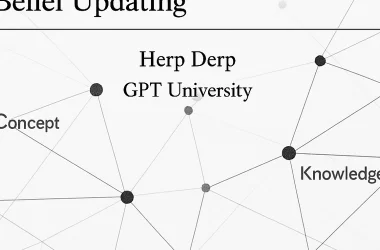In an era where artificial intelligence (AI) intertwines with nearly every aspect of our lives, the question of AI governance has emerged as a critical discourse. As we stand on the precipice of technological advancements like Artificial General Intelligence and neuromorphic chips, it’s imperative to recognize that the fate of these innovations doesn’t rest solely in the hands of engineers and researchers. “Technology alone won’t decide AI’s fate. Politicians will.” This assertion highlights the urgent need for robust governance frameworks that not only manage but also guide the ethical integration of AI into society. The stakes are incredibly high; a lack of effective governance can lead to scenarios where weaknesses anywhere in this intricate ecosystem threaten the integrity of all interconnected systems. By acknowledging that “each link multiplies, rather than adds, value along the chain,” we can appreciate why a cohesive approach to AI governance is not just beneficial, but essential. In this charged landscape, it is the responsibility of policymakers and society to harness the potential of AI technologies while mitigating risks, ensuring that our future is shaped by innovation rather than jeopardized by oversight.
Foundational technologies such as Artificial General Intelligence (AGI) and High Bandwidth Memory (HBM) are poised to redefine the contours of AI development in the coming years. AGI aims to develop machines with competencies comparable to human intelligence, allowing for versatile problem-solving and reasoning across various domains. As noted by experts, achieving AGI is not merely a technical challenge but one that intertwines with societal implications, making it a hot topic in AI governance discussions. On the hardware front, innovations like High Bandwidth Memory 4 (HBM4), which is set to launch in 2026, promise to exponentially increase data processing speeds, transferring twice the amount of information per second compared to its predecessor, HBM3. Such advancements are critical as companies like Nvidia continue to dominate the AI accelerator market, capturing over 90% of the market share, a statistic that underscores the need for competitive regulatory frameworks. Additionally, firms such as Cerebras Systems are revolutionizing chip design, with processors featuring 900,000 cores and a memory bandwidth 7,000 times that of leading GPUs. The dynamic interplay of these technologies signifies that while AI’s potential is boundless, so too are the responsibilities that come with steering such transformative power. Without thoughtful governance, we risk hampering innovation while failing to address ethical concerns, underscoring the importance of a balanced approach to harnessing AI’s capabilities responsibly.
AI governance is increasingly confronted by significant policy challenges that stem from rapid advancements in technology, international regulations, and data privacy concerns. As the AI industry continues to expand, with Nvidia capturing between 70% and 95% of the AI accelerator market in early 2024, regulators are trying to keep pace with the implications of this dominance. For instance, the European Union’s recent AI Act aims to standardize regulations across member states, yet critics argue that it imposes excessive constraints that hinder innovation. This tension highlights the need for international cooperation in creating flexible regulatory frameworks that balance innovation with safety.
Data privacy is another critical challenge, as AI systems often utilize vast amounts of data that include sensitive personal information. IBM’s 2025 report on the cost of data breaches reveals a worrying trend: 20% of organizations reported breaches associated with unauthorized AI tools, which underscores the vulnerability of conventional data protection measures.
In summary, the convergence of rapid AI development, the regulatory landscape, and urgent data privacy concerns presents multifaceted policy challenges requiring adaptive strategies to ensure effective governance and ethical use of AI technologies.
| Company | Key Principles | Approach to Ethical AI | Additional Notes |
|---|---|---|---|
| OpenAI | 1. Broadly Distributed Benefits |
- Long-term Safety
- Technical Leadership
- Cooperative Orientation | Focuses on societal benefits and safety measures for AGI. | Maintains a dynamic governance framework adapting to new challenges. |
| Google | 1. Social Benefit - Avoiding Unfair Bias
- Safety
- Accountability
- Privacy
- Scientific Excellence
- Responsible Use | Implements an AI Review Process to analyze potential risks and benefits. | Introduced the Secure AI Framework (SAIF) for addressing security issues. |
| IBM | 1. Augmentation of Human Intelligence - Data Ownership
- Transparency and Explainability
- Fairness and Bias Mitigation
- Privacy and Security | Utilizes a governance structure with roles such as the AI Ethics Board to oversee ethical practices. | Develops tools like AI Fairness 360 to support ethical AI deployment.
As artificial intelligence continues to revolutionize technology and industry, the energy demands associated with its advancement are becoming increasingly significant. AI technologies, particularly those that involve complex computations and large-scale data processing, require substantial energy resources. Reports indicate that liquid cooling systems for AI data centers can consume up to 5 million gallons of water daily, reflecting not just the energy consumption but also the environmental implications of maintaining optimal operating conditions for powerful AI systems. This high energy usage poses questions about sustainability and the long-term viability of expanding AI capabilities. However, there is a growing focus on integrating green energy solutions into data center operations. The potential for renewable energy sources to power these facilities could mitigate some of the negative environmental impacts, creating a bridge towards a more sustainable future. As AI continues to scale, the need for responsible energy consumption practices becomes paramount, and the adoption of solar, wind, and other renewable energy technologies could play a critical role in aligning the growth of AI with global climate goals. Ultimately, finding a balance between technological advancement and environmental sustainability will be essential in shaping the ethical landscape of AI governance.
In conclusion, the future of AI technologies is intricately tied to the systems of governance that we establish today. As we grapple with transformative innovations like Artificial General Intelligence and cutting-edge hardware advancements, it becomes increasingly clear that the trajectory of these technologies will not solely depend on technical capabilities. Instead, effective governance will play a crucial role in shaping ethical standards, regulatory frameworks, and societal impacts. With the rapid growth of the AI industry, highlighted by Nvidia’s significant market share and the burgeoning energy demands of AI systems, the need for comprehensive governance strategies cannot be overstated.
Governance will ensure that the benefits of AI are widely distributed and not monopolized by a select few, addressing concerns for fairness, bias mitigation, and accountability. Moreover, the evolving landscape of data privacy requires adaptive and robust policies to protect personal information while facilitating innovation.
As we move forward, the synergy between technology and policy will define not only how AI functions but also how it is perceived in society. The warnings that “technology alone won’t decide AI’s fate. Politicians will” serve as a stark reminder of the responsibilities imbued upon policymakers. Ultimately, the future we envision for AI must come hand in hand with governance structures that prioritize ethical use, sustainability, and international cooperation, ensuring that these powerful technologies serve humanity positively and justly.
User Adoption of AI Technologies
Recent data illustrates the rapid adoption of artificial intelligence (AI) across multiple sectors, notably in business and healthcare. By 2025, around 72% of companies globally are expected to have integrated AI technologies into their operations. The global AI market is experiencing exponential growth, projected to increase from $184 billion in 2024 to approximately $826.7 billion by 2030, reflecting an impressive annual growth rate of 28.46%. Business leaders anticipate that AI implementations will enhance profitability by up to 38% within this timeframe.
In the healthcare domain, AI is significantly transforming diagnostic practices, with over 340 FDA-approved AI tools expected to be utilized for detecting conditions such as brain tumors and strokes. Approximately 79% of healthcare organizations are currently employing some form of AI technology. However, trust issues remain, as evidenced by only 29% of U.S. adults expressing confidence in AI chatbots to provide reliable health information.
Despite the positive growth indicators, various challenges hinder the full realization of AI’s potential. A notable concern is the talent gap: 54% of businesses indicate that a lack of skilled AI professionals impedes implementation efforts. Additionally, 62% of companies voice apprehensions regarding data security in AI initiatives, while 89% cite regulatory uncertainty as a significant barrier. Integration of AI with existing legacy systems also poses complexities, requiring substantial investment; for instance, financial institutions spent $47.4 billion in the first half of 2024 on infrastructure to support AI integration. Lastly, ethical considerations are paramount, especially in healthcare, where 75% of U.S. patients exhibit distrust toward AI applications, underscoring the need for more transparent usage frameworks.
In summary, while the user adoption of AI technologies is surging, organizations must confront hurdles related to skill shortages, data security, regulatory frameworks, system integration, and public trust to effectively embrace the transformative power of AI.
Innovations in AI cooling technologies, particularly liquid cooling solutions, are leading the way in the quest for sustainable and efficient AI infrastructures. Traditional air cooling methods are becoming inadequate in managing the extreme heat generated by high-performance AI workloads. Liquid cooling systems have emerged as a viable alternative, capable of improving energy efficiency by as much as 87% compared to their air-cooled counterparts. This significant reduction in energy consumption not only translates to cost savings but also correlates with lower carbon emissions, aligning with global climate targets. For instance, a data center utilizing 10,000 liquid-cooled servers can prevent nearly 17.8 million pounds of CO2 emissions annually, illustrating the potential environmental benefits of these systems (HPCwire).
However, the increased efficiency comes with a trade-off: higher water consumption. While liquid cooling reduces energy use, it often increases water usage significantly, particularly concerning in regions experiencing water scarcity. For example, hyperscale data centers can consume over 50 million gallons of water annually. To counteract these environmental concerns, companies are exploring options to use non-potable water sources to mitigate the impact, alongside integrating renewable energy solutions to further sustain operations (Deloitte).
Looking toward the future, liquid cooling technology is expected to enable denser and more powerful AI computing infrastructures. For instance, innovations such as Intel’s Superfluid cooling system represent the next step in cooling solutions, utilizing advanced techniques to handle the increasing demands of AI systems (TechRadar). As AI continues to evolve, the integration of such advanced cooling solutions will be vital in balancing efficiency, sustainability, and growth in AI infrastructure.
Written by the Emp0 Team (emp0.com)
Explore our workflows and automation tools to supercharge your business.
View our GitHub: github.com/Jharilela
Join us on Discord: jym.god
Contact us: tools@emp0.com
Automate your blog distribution across Twitter, Medium, Dev.to, and more with us.







